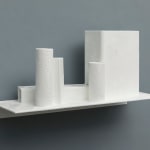

Pedro Cabrita Reis
Suite Morandi #4, 2017
oil on steel
26.5 x 51.2 x 18.5 cm
Cabrita is not interested in contingencies that isolate and/or fragment artworks chronologically or conceptually over the course of history: 'The work by Morandi has a mysterious quality, an inner silence...
Cabrita is not interested in contingencies that isolate and/or fragment artworks chronologically or conceptually over the course of history: "The work by Morandi has a mysterious quality, an inner silence that has always intrigued me…". Works from the Suite Morandi series were exhibited together with three still lifes by Giorgio Morandi. In the words of the artist: “The exhibition was an occasion of contact between two authors from different times and with distinct biographies and this allows us to reflect on the question, ‘...what is exactly contemporaneity, after all?’…"
Cabrita’s work has steadily received international acknowledgement, thus becoming crucial and decisive for the understanding of sculpture from the mid-1980’s onwards. His complex work can be characterised by an idiosyncratic philosophical and poetical discourse embracing a great variety of means: painting, sculpture, photography, drawing, and installations composed of industrial and found materials and manufactured objects. By using simple materials that are submitted to constructive processes, Cabrita recycles almost anonymous reminiscences of primordial gestures and actions repeated in everyday life. Centred on questions relative to space and memory, his works gain a suggestive power of association which reaches a metaphorical dimension by going beyond the visual. The complex theoretical and formal diversity of the work of Cabrita proceeds from an anthropological reflection, which is contrary to the reductionism of sociological discourse. In fact, it is on silences and investigations that his work is based and built on.
Cabrita’s work has steadily received international acknowledgement, thus becoming crucial and decisive for the understanding of sculpture from the mid-1980’s onwards. His complex work can be characterised by an idiosyncratic philosophical and poetical discourse embracing a great variety of means: painting, sculpture, photography, drawing, and installations composed of industrial and found materials and manufactured objects. By using simple materials that are submitted to constructive processes, Cabrita recycles almost anonymous reminiscences of primordial gestures and actions repeated in everyday life. Centred on questions relative to space and memory, his works gain a suggestive power of association which reaches a metaphorical dimension by going beyond the visual. The complex theoretical and formal diversity of the work of Cabrita proceeds from an anthropological reflection, which is contrary to the reductionism of sociological discourse. In fact, it is on silences and investigations that his work is based and built on.

